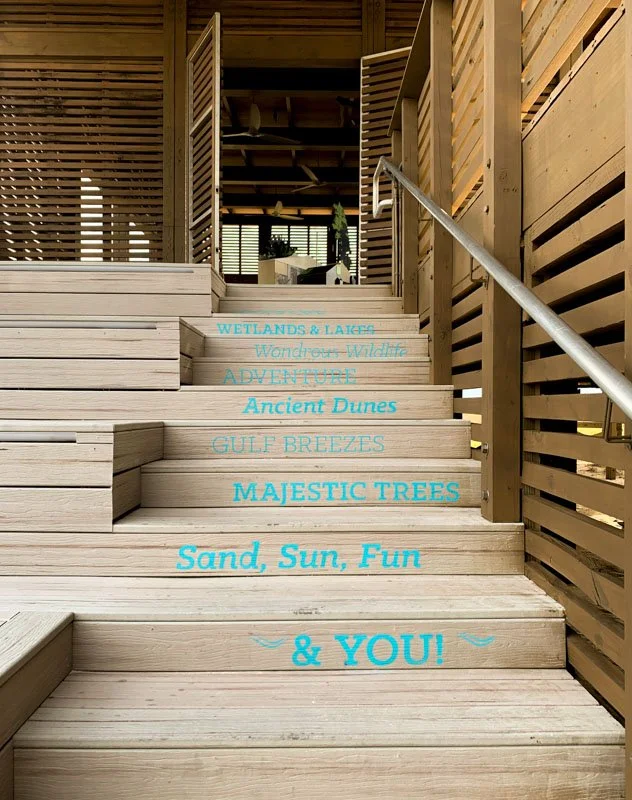Gulf State Park Interpretive Center
Alabama’s first Living Building demonstrates not only resilience to the symptoms of climate change, but the possibility of a cure.
Watershed served as the Gulf Coast Sustainability Specialist for the Gulf Coast Interpretive Center, working with the design team to help achieve and document the 20 Imperatives of the Living Building Challenge and achieve LEED Platinum, and Fortified Commercial Certification. The design team was led by Architecture Works out of Birmingham AL.
Watershed performed a Life Cycle Assessment of all of the materials used in construction. This data was used to calculate a carbon offset that will remove 172 Metric Tons of carbon from the atmosphere, via tree planting and renewable energy projects. This is more carbon than was introduced into the atmosphere by the harvest, extraction, manufacture and transport of the building materials.
The Interpretive Center is designed to be energy and carbon positive: a 1,48k kW solar array produces more energy than the building consumes, with battery storage for resilience. Steps were also taken steps to offset the embodied carbon of the building materials.
Carbon Positive buildings are a critical tool to fight climate change. As coastal communities are faced with increasingly frequent storms and sea level rise, the Interpretive Center demonstrates not only resilience to the symptoms of climate change, but the possibility of a cure.
A Restorative Impact
The Interpretive Center has an 11,000 gallon rainwater cistern. The restrooms, sinks, and water play area use only rain water harvested from the roofs on site and filtered for use. After it is used, that water is purified and returned to the ground for infiltration into a fresh water aquifer under the park, thus restoring the native hydrology of the site. There are significant regulatory hurdles for a small, public project to achieve Net Positive water in this way. In order to “go off the grid” with its water, the Interpretive Center had to become certified as a water treatment plant through the Alabama Department of Environmental Management (ADEM).
Every ingredient of every single building material used on the Interpretive Center construction, from the wood, to the screws, the roof membrane, to the wiring inside the lighting fixtures, has been carefully vetted to identify and eliminate Red List chemicals of concern.
The Red List includes the worst in class persistent biological toxins, known to cause harm to humans and ecosystems. Unfortunately, these chemicals are also quite prevalent in common building materials.
Extensive research and communication with manufacturers and their supply chains goes into creating a living building. This work, to publicly disclose building material ingredients, and their health impacts, is helping to transform markets, and eliminate the red list chemicals from use.
Taking the idea “buying local” to a whole new level.
50% of the building materials are sourced within 620 miles of the site, and 20% of those come from within about 300 miles of the site. Most of our design team is Alabama based. This extreme commitment to local sourcing not only supports our local foresters, manufacturers, and businesses, but it also eliminates the pollution that is a result of trucking-in building materials (and even flying design team members) over long distances.
An Immersive Experience
The building design was also guided by the principle of biophilia. This term was coined by E.O. Wilson, an Alabama native who has had a tremendous impact on the world of ecology. Biophilia means, literally, “love of life.” At the beginning of the design process, Watershed led a full day biophilic design workshop, to immerse the design team in the ecosystems of Gulf State Park and set goals for a biophilic visitor experience.
The Interpretive Center shade structures are influenced by the dappled, filtered light of the maritime oak forests deep in the park. Both the building and porch are intended to offer a dramatic, but safe, platform from which to see and hear the intense rains of the gulf in an immersive experience. The pedestrian overpass from the park to the beach was designed to point travelers towards views of the prehistoric dunes within the park, the mature tertiary dunes across the beach highway, and the developing primary and secondary dune systems at the site. The dunes are off limits to most visitors to the Gulf Coast, because of their fragile nature, but the sand and water play area at ground level allows guests to experience the dunes from a different perspective and see the system grow before their eyes.
What is a Living Building?
The Living Building Challenge (LBC) is the most stringent and rigorous green building certification in the world. LBC goals are more ambitious than just minimizing harm to the environment. Instead, LBC challenges teams to create buildings that have a restorative impact on human and ecological communities.
The Interpretive Center achieved Living Building Petal Certification – earning 19 of the 20 imperatives in the Living Building Challenge.
This project is sponsored by the U.S. Department of Treasury in cooperation with the State of Alabama Department of Conservation and Natural Resources.
Project type: civic new construction
Location: Gulf Shores, AL
Certifications: Living Building Petal Certified, targeting LEED Platinum Certification, FORTIFIED Commercial™
Key Stats:
Net Positive Energy, Water, and Carbon
11,000 Rainwater Cistern
Composting Toilets
1.48kW Solar Array
172 metric ton Carbon Offset










